Investment Casting
Investment casting is a highly versatile manufacturing process used to create a broad spectrum of lightweight industrial components. The name “investment casting” originates from the ceramic slurry that coats a wax pattern, forming a durable ceramic shell. This method is widely recognized for its exceptional precision and reliability, earning it the alternate name of precision casting. Additionally, it is often referred to as the “lost-wax process,” “lost wax casting,” or simply "wax casting" due to the way the wax model is melted away, or “lost,” during production.
Beyond industrial applications, lost wax casting and precision investment casting are terms that also describe a technique for replicating metal sculptures. However, in an industrial setting, this process is entirely dedicated to manufacturing machine parts, leveraging the same foundational principles as wax cast sculpting to achieve intricate and accurate results.
Many manufacturers rely on investment casting for producing highly detailed and dimensionally precise components. This process supports a diverse range of alloys and specifications, making it an essential technique across numerous industries. Investment cast components are widely used in aerospace, automotive, chemical, defense, food processing, electrical, railroad, mechanical, marine, electronic, textile, and engineering applications, demonstrating the process’s adaptability and reliability.
Investment Casting FAQs
What is investment casting used for in manufacturing?
Investment casting is used to produce lightweight, dimensionally precise metal components. It supports a wide range of alloys and is ideal for aerospace, automotive, defense, food processing, and industrial equipment applications requiring intricate detail and tight tolerances.
Why is investment casting also called the lost-wax process?
Investment casting is known as the lost-wax process because the wax model used to create the mold is melted and “lost” before molten metal is poured in. This technique allows manufacturers to form parts with smooth finishes and intricate details.
What materials are commonly used in investment casting?
Common materials include stainless steel, carbon steel, aluminum, brass, copper, and titanium. Both ferrous and non-ferrous alloys are used, depending on the strength, corrosion resistance, and weight requirements of the application.
What are the main advantages of investment casting?
Investment casting offers high precision, excellent surface finish, minimal material waste, and reduced machining. It supports complex designs and produces consistent, reliable results while maintaining cost efficiency and environmental sustainability.
How does investment casting differ from sand casting?
Investment casting uses a ceramic mold built around a wax pattern, ideal for smaller, intricate parts up to around 695 pounds. Sand casting uses sand and clay molds suited for larger components up to about 2,200 pounds but with lower surface precision.
What industries commonly use investment casting?
Industries such as aerospace, automotive, chemical, defense, marine, and food processing rely on investment casting for producing high-quality metal parts that require accuracy, strength, and complex geometries.
What factors should be considered when designing for investment casting?
Designers should evaluate flexibility, surface finish, tensile strength, part weight, and production volume. These factors influence material selection, mold design, and the overall efficiency and quality of the final cast component.
The History of Investment Casting
Investment casting is one of the oldest known industrial processes, with origins dating back over 5,000 years. The earliest recorded description of investment casting was written around 1100 A.D. by a monk using the pseudonym Theophilus Presbyter. However, by that time, the process had already been in practice for centuries. Early castings have been discovered in the tombs of King Tut and among the artifacts of ancient civilizations such as Harappa, Mesopotamia, the Aztec and Mayan cultures of Mexico, and the Benin civilization of Africa.
In its earliest forms, investment casting relied on natural honeycomb or beeswax for wax patterns, while clay served as the molding material. Operators manually worked bellows to stoke furnaces and melt metals. Today, the process has advanced significantly, incorporating a variety of pure and synthetic waxes for pattern creation, and utilizing refractory materials and specialized alloys to produce durable molds. Modern cast foundries have replaced traditional handheld bellows, allowing for greater precision and efficiency.
The transition to modern investment casting began in the late 1800s, when dentists started using the process to craft crowns and fillings. However, it was during World War II that investment casting became an essential industrial manufacturing method. Engineers adapted the process to work with high-performance alloys, facilitating precision net shape and near-net shape production for military and aerospace applications.
Now a cornerstone of modern manufacturing, investment casting continues to evolve, offering unparalleled precision and versatility across numerous industries.
Advantages of Investment Casting
The investment casting process offers a wide array of advantages, making it a preferred method for producing high-quality industrial components. Its benefits include cost efficiency, minimal material waste, high reliability, environmental sustainability, and the ability to manufacture highly detailed parts with exceptional surface finishes.
- Low Production Costs
- Investment casting reduces production costs compared to alternative methods like metal fabrication. By requiring less labor and fewer raw materials, it lowers capital expenditures while maintaining efficiency. The process also eliminates the need for additional welding, assembly, or finishing work, further cutting costs and increasing profit margins.
- Low Wastage and Fewer Time Delays
- Unlike machining, which often generates significant material waste, investment casting minimizes excess material usage. Reducing waste helps lower production costs and prevents unnecessary financial losses. Additionally, machining processes can be time-intensive, leading to production delays, whereas investment casting streamlines production, ensuring on-time delivery without unnecessary setbacks.
- High Reliability
- Investment casting, along with specialized techniques such as brass investment casting, aluminum investment casting, and forging, is one of the most reliable manufacturing methods for producing high-precision machine parts. Engineers maintain strict control over every stage of the process, ensuring that each component meets exact specifications with consistency and precision.
- Environment Procurement
- Investment casting is an environmentally responsible manufacturing method. The process efficiently utilizes resources by reusing most wax patterns multiple times, significantly reducing material waste. This sustainability factor makes investment casting an eco-friendly option for companies looking to reduce their environmental footprint.
- Complexity, Details, and Quality
- Investment casting enables the creation of lightweight, highly complex parts with intricate details that other manufacturing methods struggle to achieve. It allows for greater design flexibility, a broad selection of metal alloys, and superior surface finishes. Because each investment cast part is formed as a single, solid piece, it lacks seams, joints, or flash lines, resulting in increased durability and reduced susceptibility to breakage.
- Investment casting remains an essential process in industrial manufacturing, combining efficiency, precision, and sustainability to produce high-quality components across a wide range of applications.
Design of Investment Casting
Investment casting begins with the creation of castings from either an original wax model or wax replicas of a master pattern. The first approach, known as the direct method, involves crafting the casting directly from the original wax model. The second, called the indirect method, does not require the master pattern to be wax and instead uses a duplicate wax replica. The following sections outline the intricate stages of investment casting, detailing the steps from initial pattern creation to the final casting process.
- Creating the Master Pattern
- The investment casting process begins with the development of a master pattern, meticulously designed to match the specifications of the intended component. Engineers or artists dedicate hours or even days to refining the master pattern, ensuring its exact conformity to design requirements. This pattern is first conceptualized on paper, where detailed calculations guide its dimensions and shape before transitioning into physical form.
- Creating the Mold
- Once the master pattern is complete, a mold is created based on its measurements. Depending on the component's needs and material properties, the mold may be temporary or permanent. Wax, clay, or plastic are common choices for mold materials, though in some cases, molten metal alloys such as steel or alloy steel can be used to form a highly durable and precise mold. Additionally, materials like rubber and frozen mercury are sometimes employed, further expanding the range of possibilities for mold fabrication.
- Producing and Assembling the Pattern
- To create the wax pattern, molten wax is poured into the mold and left to solidify until it forms a hard, uniform coating. Manufacturers can produce multiple identical wax patterns, enabling the creation of a cluster of patterns when necessary. These patterns are then attached to a central channel known as a sprue, forming an assembly commonly referred to as a tree. This step ensures that multiple investment cast parts can be processed simultaneously, improving efficiency and production output.
- Applying the Investment Materials
- The term "investment" refers to the ceramic mold that encases the wax pattern. This mold is built up through a meticulous process of coating, stuccoing, and hardening the wax pattern cluster multiple times until the desired thickness is achieved. Each layer adds strength to the mold, and the entire process may take several days to complete. The final result is a durable ceramic shell capable of withstanding extreme temperatures and pressures during casting.
- Dewaxing Staging
- Once the ceramic mold is fully formed and hardened, the dewaxing stage begins. This step is crucial, as it removes the wax pattern from inside the mold. If the mold was made using wax, this process is relatively straightforward, involving heating the mold in an oven to melt and drain the wax. However, for molds formed from metal melts, the removal process requires specialized electric tools and precise hand movements to extract the material without damaging the mold.
Features of Investment Casting
Investment casting is based on a simple yet highly effective concept: forming a mold around a wax pattern that is then melted away, leaving a hollow shell ready to be filled with molten metal.
The process begins with the wax model, which is attached to a sprue. Hundreds of wax patterns may be affixed to the same sprue, creating a "tree" that allows multiple parts to be cast simultaneously. Once the assembly is complete, it is repeatedly dipped into a ceramic slurry and coated with a coarse material such as sand. The ceramic layers build up to form a thick investment, which is then placed into an oven where temperatures reach over 1000°F. The wax inside the mold melts and drips out, leaving behind a hollow shell that maintains its precise shape.
At this stage, the molten metal is heated to the required temperature and poured into the ceramic shell. The liquid metal travels along the pathways left by the sprue, filling every cavity and impression left by the original wax pattern. Once the metal cools and solidifies, the ceramic shell is broken away, and the cast parts are separated from the sprue. At this point, the investment cast components may undergo additional machining and finishing, though they require far less post-processing than other casting methods.
Investment casting is a carefully controlled process, with manufacturers employing fans and blowers to remove airborne dust, including silica particles that could be hazardous if inhaled. To ensure the highest quality, vacuums are often used to extract air bubbles from the investment slurry, preventing imperfections in the final cast. Advanced ovens and furnaces maintain precise temperature control during burnout, while specialized heating equipment ensures that alloys are melted to their optimal pouring temperature.
Modern advancements in materials science and engineering have further enhanced the investment casting process, allowing manufacturers to fine-tune the chemical composition of both the mold and the final cast product. By carefully selecting materials, they can control specific properties such as durability, magnetism, and weight capacity while avoiding unwanted characteristics. This scientific approach ensures that each investment cast part meets exact performance requirements.
Investment casting has withstood the test of time, proving its value across thousands of years. Even in the modern age, it remains a cost-effective, efficient, and environmentally responsible method for producing precision metal components. By minimizing waste, reducing machining needs, and offering unmatched design flexibility, investment casting continues to be a preferred choice in industrial manufacturing.
Investment Castings Images, Diagrams and Visual Concepts
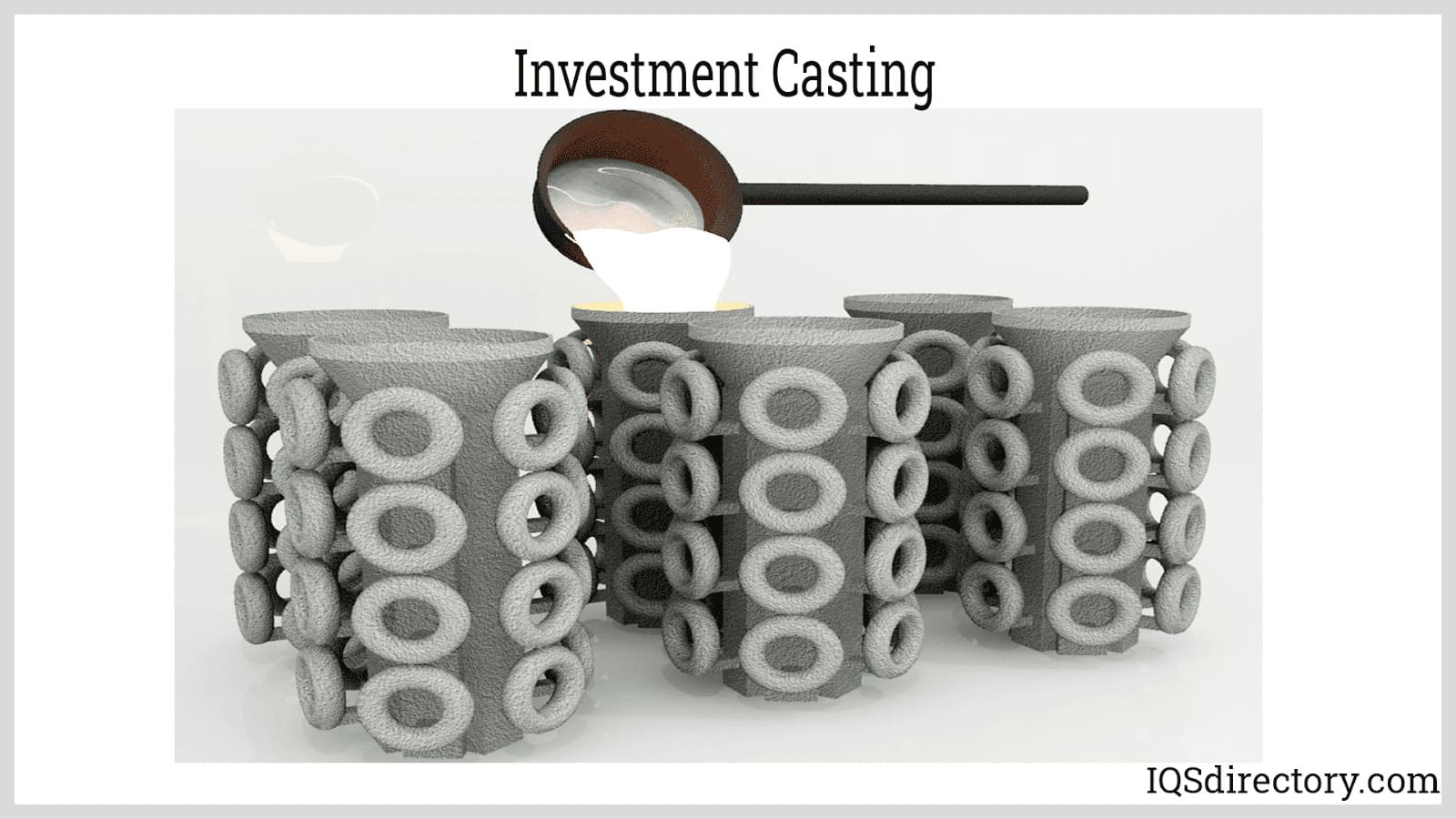 Using a ceramic shell built over a wax pattern which can produce parts with uniformity and even surfaces.
Using a ceramic shell built over a wax pattern which can produce parts with uniformity and even surfaces.
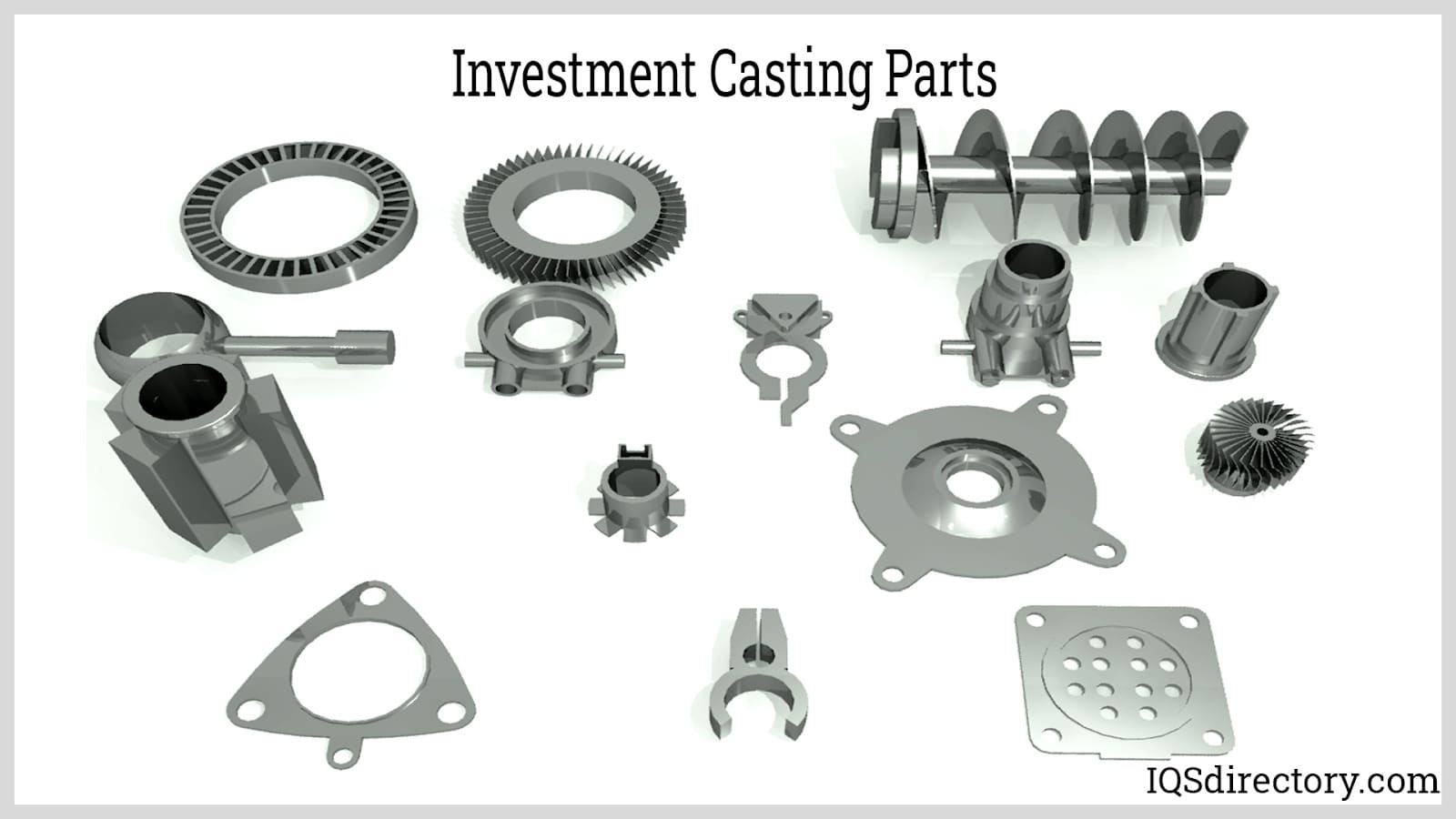 Examples of parts made with investment casting.
Examples of parts made with investment casting.
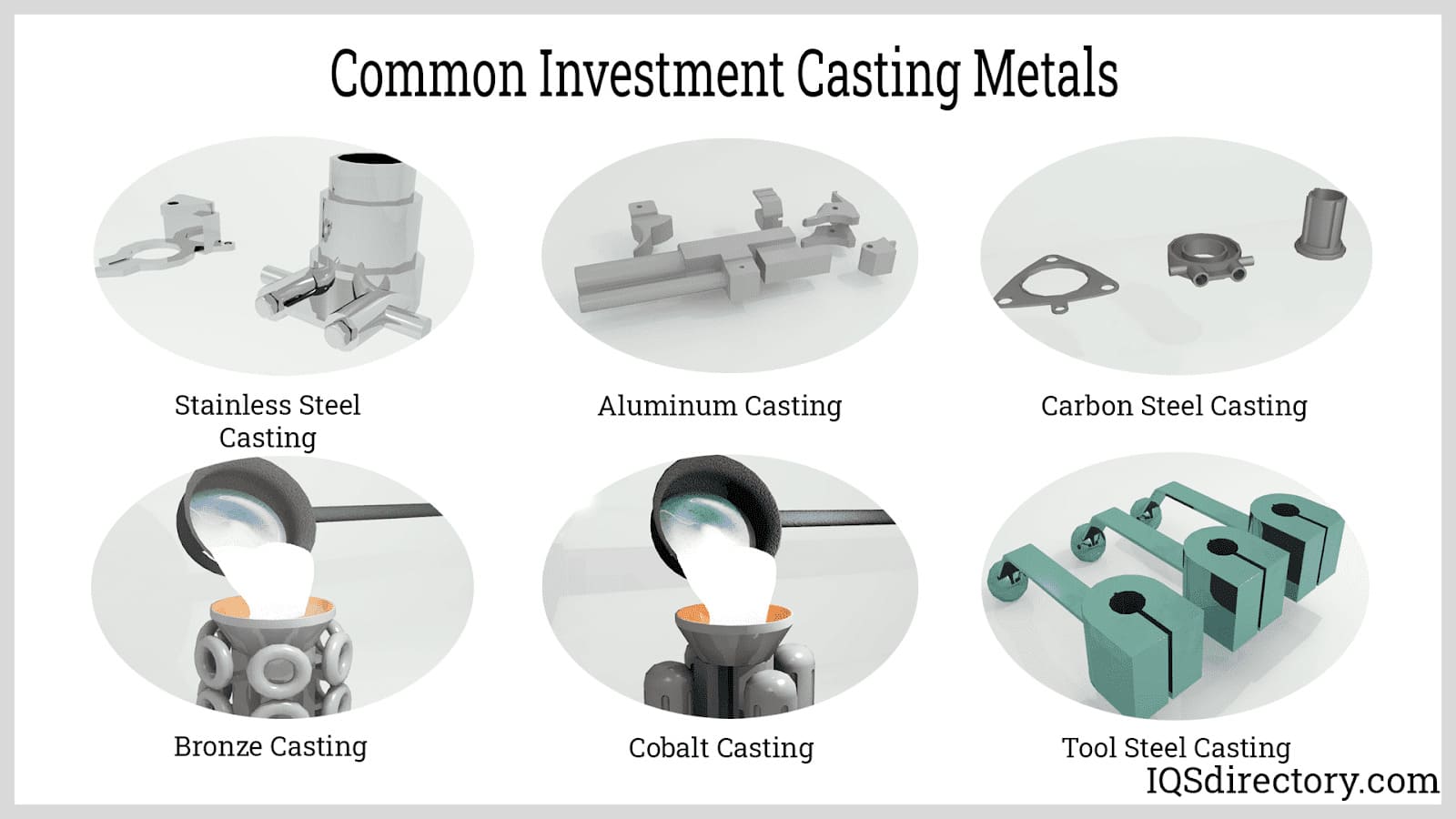 The common metals used in the casting process.
The common metals used in the casting process.
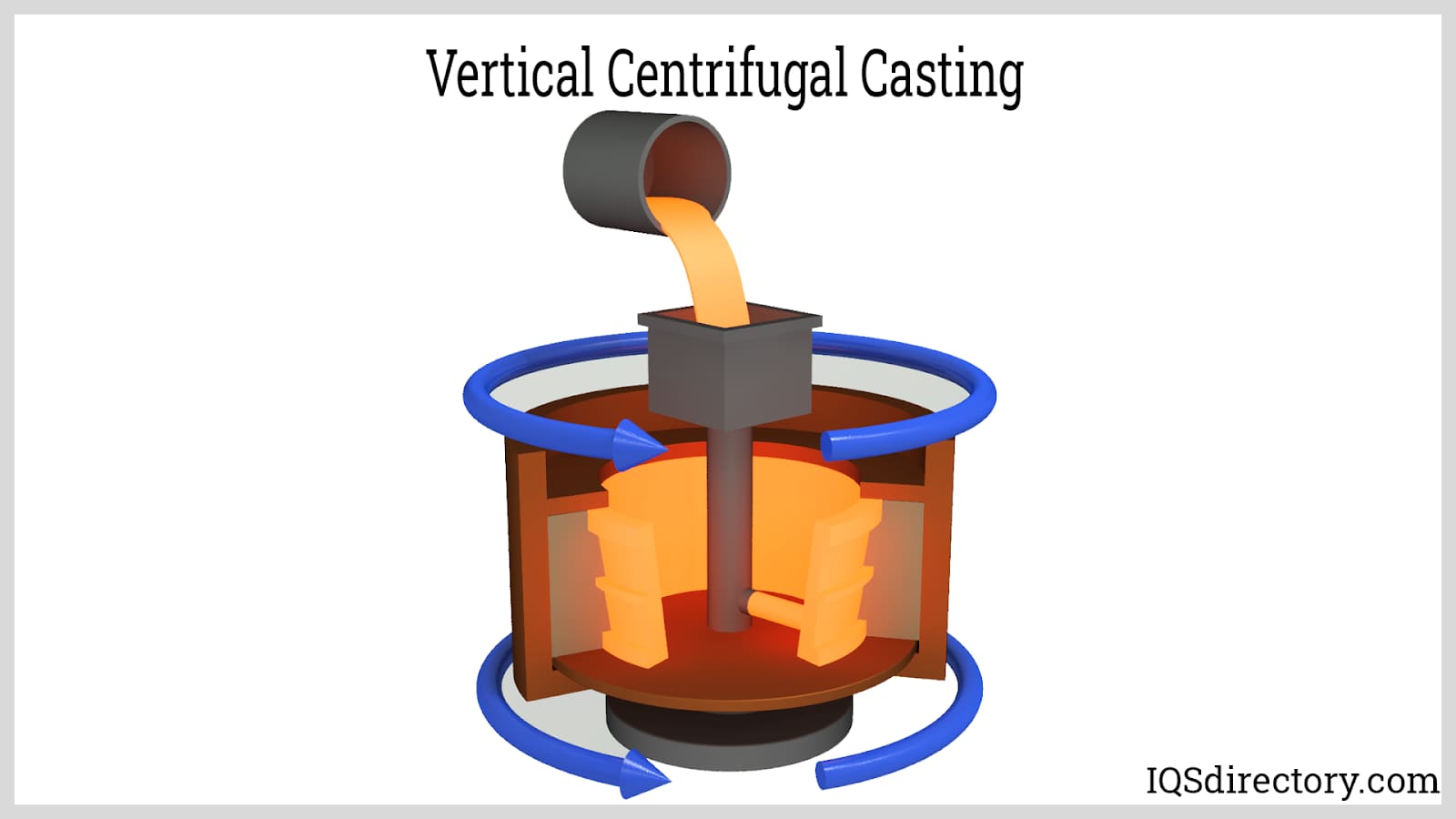 The equipment is placed vertically and spun at a vertical axis, the molten material is poured into at the top of the casting equipment.
The equipment is placed vertically and spun at a vertical axis, the molten material is poured into at the top of the casting equipment.
 The equipment is set horizontal and spun at a horizontal axis while end is sealed, with a pour basin at the opposite end.
The equipment is set horizontal and spun at a horizontal axis while end is sealed, with a pour basin at the opposite end.
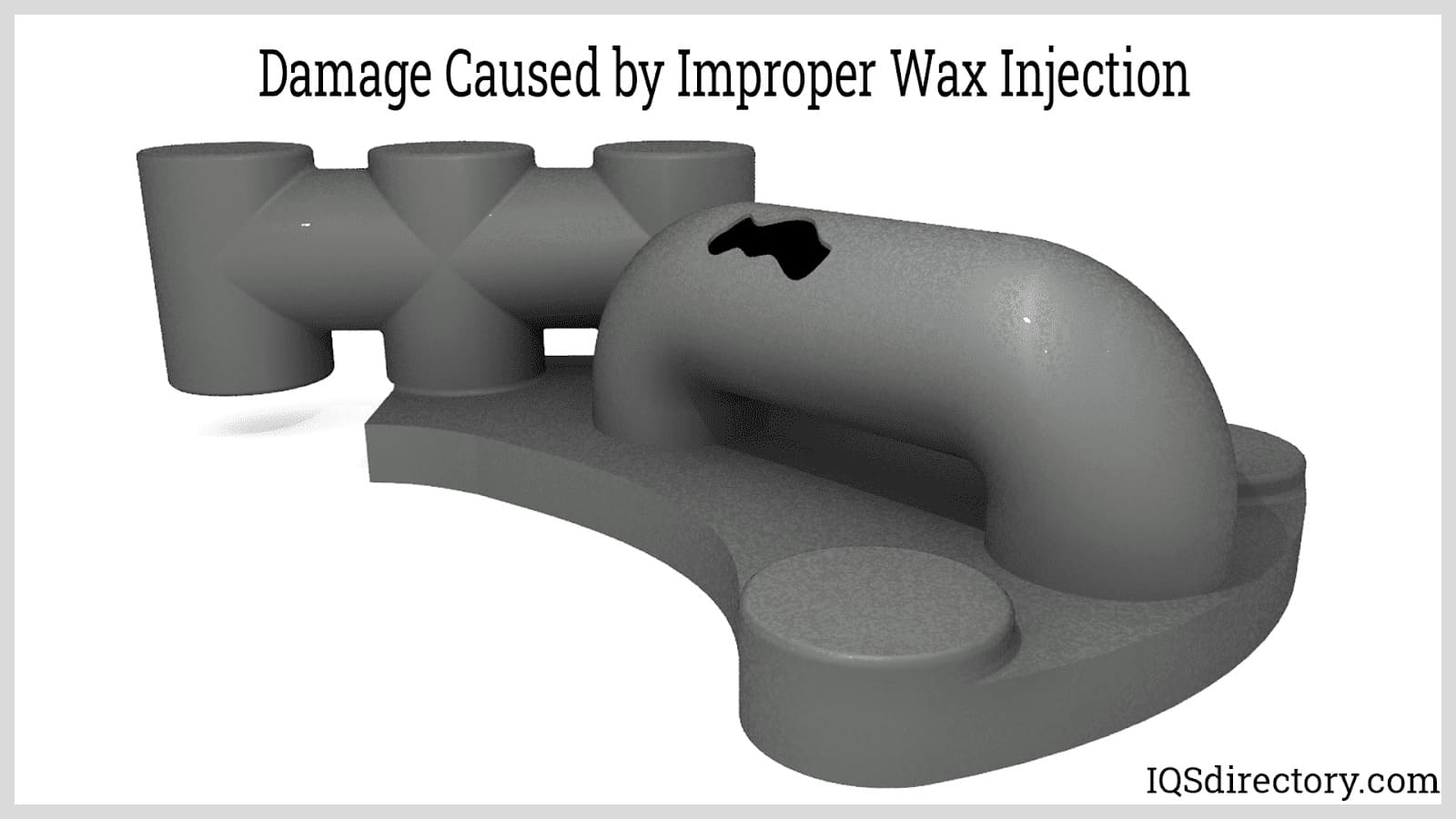 Improperly using the the wax mold could result in damage to the product being molded.
Improperly using the the wax mold could result in damage to the product being molded.
Investment Castings Types
- Aluminum Investment Casting
- Aluminum investment casting produces industrial components through the precise replication of wax models using molten aluminum. The resulting parts exhibit exceptional dimensional accuracy, smooth surface finishes, and intricate details, all without the presence of flash or parting lines. Aluminum and its alloys are among the most widely used metals in investment casting due to their lightweight properties, corrosion resistance, and versatility across multiple industries.
- Brass Investment Casting
- Brass investment casting follows the same manufacturing principle, utilizing molten brass to replicate wax patterns and create finely detailed, seamless components. This process ensures high precision and lightweight parts with a smooth finish, making it ideal for applications requiring aesthetic appeal, conductivity, and durability.
- Centrifugal Casting
- Centrifugal casting is a specialized technique used to produce parts with thin walls and uniform density. This process is particularly effective for manufacturing cylindrical components or stock parts in standard sizes, which may later be machined into final products. By using centrifugal force to distribute molten metal within a mold, manufacturers achieve excellent structural integrity and consistent material properties.
- Copper Investment Casting
- Copper investment casting utilizes liquid copper to create strong, lightweight components with fine surface finishes and intricate detailing. Due to copper’s excellent electrical and thermal conductivity, its investment cast parts are widely used in industries such as plumbing, electrical systems, machine tools, mixing equipment, lock manufacturing, and jewelry production.
- Ferrous Investment Castings
- Ferrous investment casting refers to the production of components made from iron-containing metals, including 300- and 400-series stainless steels, carbon and alloy steels, as well as cobalt and tool steels. These castings are known for their strength, durability, and resistance to wear, making them essential in demanding industrial applications.
- Investment Casting Process
- Investment casting, also known as precision casting or lost-wax casting, is a highly accurate manufacturing method that enables the production of complex parts. The process involves creating a wax model, coating it with a ceramic shell, melting away the wax, and then pouring molten metal into the resulting cavity. The final product is a highly detailed, dimensionally precise component that requires minimal machining.
- Investment Casting Products
- Investment casting produces a vast array of metal parts in nearly any castable material, including carbon steel, stainless steel, aluminum, copper, titanium, and brass. Since the wax model is an exact replica of the final product, investment cast components achieve tight tolerances and superior surface finishes, making them ideal for aerospace, automotive, medical, and industrial applications.
- Lost Wax Casting
- Lost-wax casting is a traditional process that involves crafting a wax model, coating it with a refractory material to create a mold, melting away the wax, and then pouring molten metal into the hollow mold. Once the metal cools and solidifies, the outer ceramic shell is removed, revealing the final cast component with precise detailing and a smooth finish.
- Non-Ferrous Investment Castings
- Non-ferrous investment castings are those made from metals that do not contain iron, such as aluminum and copper-based alloys. These castings are known for their lightweight properties, corrosion resistance, and ease of fabrication, making them suitable for industries requiring non-magnetic and non-rusting components.
- Precision Investment Casting
- Precision investment casting refers to the high-accuracy, low-tolerance casting method that allows manufacturers to produce intricate metal components with consistent quality. This process is essential for industries that demand precision, such as aerospace, medical, and automotive manufacturing, where complex geometries and near-net-shape parts are required.
- Stainless Steel Investment Casting
- Stainless steel investment casting is a specialized process in which molten stainless steel is poured into a mold created from a wax pattern. These parts feature smooth finishes that require minimal machining and are free of flash or parting lines since they are cast as single, solid pieces. Stainless steel investment castings are highly durable and resistant to corrosion, making them ideal for applications requiring sanitary conditions or exposure to harsh environments, such as chemical processing, medical equipment, and food handling.
- Steel Investment Castings
- Steel investment casting is a type of ferrous casting in which components are manufactured using stainless and carbon alloy steels. This method produces highly complex or small parts that are difficult to machine using conventional methods. Because steel investment casting eliminates the need for welding, assembly, and finishing work, it is a cost-effective and efficient manufacturing solution for industries requiring high-strength components.
- Titanium Investment Casting
- Titanium investment casting is a precise manufacturing process that replicates wax models using molten titanium. The resulting parts feature exceptionally smooth finishes and require little post-processing. Investment casting is particularly effective for producing highly intricate titanium components without seams or joints. Due to its superior strength-to-weight ratio, titanium is widely used in aerospace, defense, power generation, marine, transportation, and medical applications, where lightweight yet high-performance parts are critical.
- Wax Casting
- Wax casting, also known as the lost-wax process, involves creating a wax pattern to form a ceramic mold, which is then filled with molten metal. Because the wax pattern produces a smooth mold interior, the final cast part requires little additional machining. This method is particularly advantageous for producing intricate designs and detailed components that other manufacturing processes struggle to achieve.
Standards and Specifications of Investment Castings
The standards to which you’ll want your manufacturer to adhere when making your investment cast parts depend upon your application, industry, and region. For example, if you’ve requested a part for a military application, you’ll want it to meet Mil-Specs. Likewise, your investment cast part may need to meet FDA, ADA, OSHA, EPA or any other host of standards. Make sure you know what those are by discussing your industry and your specs with your supplier. For the best and most reliable investment cast parts, you’ll also want your manufacturer to follow the manufacturing standards of ISO (International Standards Organization).
Things to Consider When Choosing Investment Casting
- Questions to Consider With Investment Casting
- If you're uncertain about whether investment casting is the ideal choice for your project, consider the following key questions:
- Does your part require exceptional precision and intricate detail? If so, investment casting is an excellent option.
- Do you need to achieve close dimensional accuracy? If precision is crucial, investment casting is well-suited for the job.
- Are you searching for an alternative to machining that delivers high quality with lower tooling costs? Investment casting can be a cost-effective and efficient solution.
- What is your application's weight requirement? Investment casting works best for components up to approximately 695 pounds.
- If your project exceeds this weight limit, alternative casting methods such as sand casting may be a better fit. Sand casting accommodates much larger castings—up to 2,204.62 pounds (1,000 kilograms). Instead of wax patterns, sand casting uses a mold made by compressing a mixture of sand and clay. The mold is divided into two halves, which are assembled and filled with molten metal. Once the metal cools and solidifies, the mold is opened, the cast part is removed, and any residual sand and clay are cleaned off.
- Considering Design Factors
- After choosing investment casting, design factors become the next crucial consideration. These factors include:
- Required flexibility – How much variation does your part require?
- Surface finish – What level of finish quality is needed?
- Tensile strength – How much force must the part withstand?
- Weight requirements – What are the material and load constraints?
- Production volume – How many parts will be manufactured in a given time frame?
- Each of these elements influences the material selection, mold design, and final production efficiency.
- Considering a Manufacturer
- Choosing the right investment casting manufacturer is just as important as selecting the process itself. With many manufacturers offering investment casting services, finding the right partner can be challenging. Look for a manufacturer that is committed to quality, customer service, and achieving the best results for your project.
Proper Care for Investment Castings
Caring for investment cast parts depends on the specific material and application. While general recommendations include storing cast components in a dry, controlled environment and avoiding loads that exceed design specifications, detailed maintenance guidelines should be obtained from the manufacturer. Understanding proper handling and maintenance practices helps extend the lifespan of investment cast parts and ensures optimal performance.
Casting Accessories
Modern investment casting is supported by advanced equipment that allows manufacturers to produce identical components with high precision. Some of the key accessories used in the process include:
3D printers – Used for rapid prototyping and creating wax patterns.
Mold frames – Provide structural support for molds during casting.
Molding rubber – Helps create flexible molds for pattern replication.
Measuring cylinders and bowls – Ensure accurate mixing of casting materials.
Crucibles and tongs – Assist in handling molten metal safely.
Easy rings – Used to secure and stabilize wax patterns in molds.
Each of these tools plays a role in streamlining the casting process and maintaining consistency in production.
Investment Casting Terms
- Alloy
- A compound consisting of two or more metals or a combination of metal and a nonmetal.
- "As Cast" Condition
- A casting that has not been heat-treated after removal from the mold.
- Burnout
- The removal of excess wax and moisture from a mold before metal is poured.
- Casting
- The process of shaping metal by pouring it into a mold and allowing it to harden.
- Cavity
- The hollow space within a mold where molten metal is poured to form the final shape.
- Centrifugal Casting
- A method in which molten metal is introduced into a rotating mold to enhance detail and uniformity.
- Ceramic Mold Process
- A technique where a mold is created from a pattern using ceramic materials.
- Ceramic Shell Process
- A method in which a wax pattern is coated multiple times in ceramic slurry and stucco to form a hardened shell.
- Cocoon Process
- A technique used to apply protective plastic coatings to metal.
- Cold Shut
- A surface defect caused by the incomplete fusion of molten metal streams.
- Concentricity
- The condition where two or more shapes share a common axis.
- Core
- A form inserted into a mold to create internal features within a casting.
- Dirty Casting
- A casting that contains unwanted non-metallic substances.
- Ferrous
- A term used to describe metals containing iron.
- Forging
- A process that reshapes metal using heat and pressure.
- Gates
- Openings in a gating system that direct molten metal into a mold cavity.
- Gating System
- A network that controls the flow of molten metal into a mold.
- Inclusions
- Foreign particles trapped in a casting during solidification.
- Injection Molding
- A process that injects molten material into a mold under pressure.
- Lost Wax Process
- A historical method of investment casting that involves replacing wax patterns with molten metal.
- Misrun
- An incomplete casting due to improper metal flow.
- Mold
- A container used to shape liquid substances into solid forms.
- Molten
- A solid that has been heated to a liquid state.
- Non-Ferrous
- Metals that do not contain iron, such as aluminum and copper-based alloys.
- Pattern
- A wax model used to create a mold for investment casting.
- Pattern Oversize Factor
- The additional size built into a pattern to compensate for metal shrinkage.
- Plaster Mold Casting
- A process in which plaster is used to form molds for casting.
- Permanent Mold Casting
- A technique where reusable metal molds are used for casting.
- Pouring Cup
- A component of the gating system that directs molten metal into a mold.
- Riser
- A cavity in the mold designed to store excess molten metal.
- Runners
- Channels that direct molten metal from the sprue to the mold cavity.
- Sand Casting
- A process where molten metal is poured into sand molds to create large cast parts.
- Shell Casting
- A method where sand and plastic are applied to a hot metal pattern to form a mold.
- Shrinkage
- The reduction in metal volume as it cools and solidifies.
- Shrinkage Allowance
- The additional material included in a pattern to compensate for metal contraction.
- Slurry
- A thick liquid mixture used to coat wax patterns and form ceramic molds.
- Solid Mold Process
- A method where a wax pattern is encased in a steel flask and filled with liquid plaster to create a mold.
- Sprue
- A channel that directs molten metal into the mold cavity.
- Straightness
- A measure of deviation from the intended axis.
- Vents
- Small openings in a mold that allow air to escape during casting.